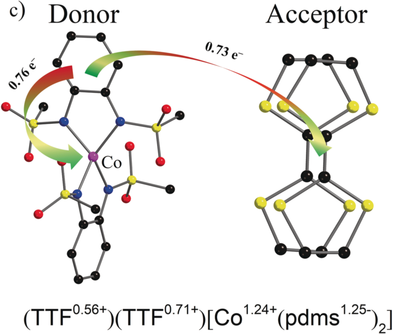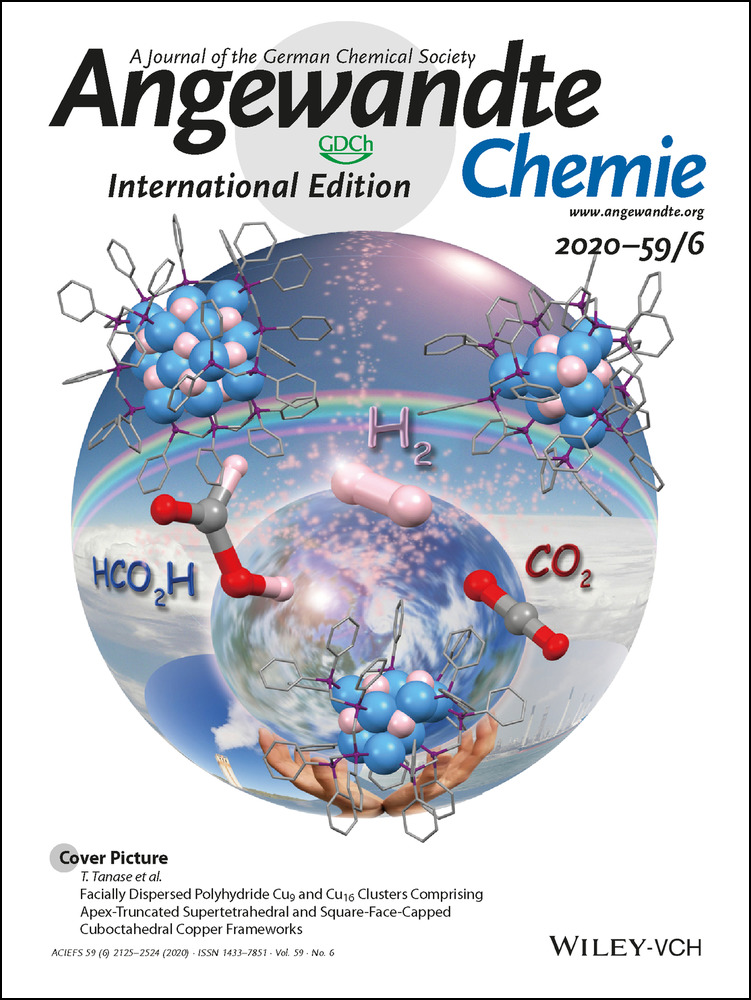An Organic–Inorganic Hybrid Exhibiting Electrical Conduction and Single-Ion Magnetism
Corresponding Author
Dr. Yongbing Shen
Department of Chemistry, Graduate School of Science, Tohoku University, 980-8578 Sendai, Japan
Search for more papers by this authorCorresponding Author
Dr. Goulven Cosquer
Department of Chemistry, Graduate School of Science, Tohoku University, 980-8578 Sendai, Japan
Present address: Research Group of Solid Material Chemistry, Graduate School of Science, Hiroshima University, 1-3-1 Kagamiyama, Higashihiroshima, Hiroshima, 739-8526 Japan
Search for more papers by this authorProf. Hiroshi Ito
Department of Applied Physics, Nagoya University, Chikusa-ku, Nagoya, 464-603 Japan
Search for more papers by this authorDr. David C. Izuogu
Department of Chemistry, University of Cambridge, Lensfield Road, Cambridge, CB2 1EW UK
Department of Pure and Industrial Chemistry, University of Nigeria, Nsukka, 410001 Enugu State, Nigeria
Search for more papers by this authorProf. Alex J. W. Thom
Department of Chemistry, University of Cambridge, Lensfield Road, Cambridge, CB2 1EW UK
Search for more papers by this authorDr. Toshiaki Ina
Research & Utilization Division (Japan) Synchrotron Radiation Research Institute, 1-1-1 Kouto, Sayo, Sayou-gun, Hyogo, 679-5198 Japan
Search for more papers by this authorDr. Tomoya Uruga
Research & Utilization Division (Japan) Synchrotron Radiation Research Institute, 1-1-1 Kouto, Sayo, Sayou-gun, Hyogo, 679-5198 Japan
Search for more papers by this authorDr. Takefumi Yoshida
Electronic Functional Macromolecules Group, National Institute for Materials Science (NIMS), Tsukuba, 305-0044 Japan
Search for more papers by this authorProf. Shinya Takaishi
Department of Chemistry, Graduate School of Science, Tohoku University, 980-8578 Sendai, Japan
Search for more papers by this authorProf. Brian K. Breedlove
Department of Chemistry, Graduate School of Science, Tohoku University, 980-8578 Sendai, Japan
Search for more papers by this authorDr. Zhao-Yang Li
School of Materials Science and Engineering, Nankai University, Tianjin, 300350 China
Search for more papers by this authorCorresponding Author
Prof. Masahiro Yamashita
Department of Chemistry, Graduate School of Science, Tohoku University, 980-8578 Sendai, Japan
School of Materials Science and Engineering, Nankai University, Tianjin, 300350 China
WPI-Advanced Institute for Materials Research (AIMR), Tohoku University, 2-1-1 Katahira, Aoba-ku, Sendai, 980-8577 Japan
Search for more papers by this authorCorresponding Author
Dr. Yongbing Shen
Department of Chemistry, Graduate School of Science, Tohoku University, 980-8578 Sendai, Japan
Search for more papers by this authorCorresponding Author
Dr. Goulven Cosquer
Department of Chemistry, Graduate School of Science, Tohoku University, 980-8578 Sendai, Japan
Present address: Research Group of Solid Material Chemistry, Graduate School of Science, Hiroshima University, 1-3-1 Kagamiyama, Higashihiroshima, Hiroshima, 739-8526 Japan
Search for more papers by this authorProf. Hiroshi Ito
Department of Applied Physics, Nagoya University, Chikusa-ku, Nagoya, 464-603 Japan
Search for more papers by this authorDr. David C. Izuogu
Department of Chemistry, University of Cambridge, Lensfield Road, Cambridge, CB2 1EW UK
Department of Pure and Industrial Chemistry, University of Nigeria, Nsukka, 410001 Enugu State, Nigeria
Search for more papers by this authorProf. Alex J. W. Thom
Department of Chemistry, University of Cambridge, Lensfield Road, Cambridge, CB2 1EW UK
Search for more papers by this authorDr. Toshiaki Ina
Research & Utilization Division (Japan) Synchrotron Radiation Research Institute, 1-1-1 Kouto, Sayo, Sayou-gun, Hyogo, 679-5198 Japan
Search for more papers by this authorDr. Tomoya Uruga
Research & Utilization Division (Japan) Synchrotron Radiation Research Institute, 1-1-1 Kouto, Sayo, Sayou-gun, Hyogo, 679-5198 Japan
Search for more papers by this authorDr. Takefumi Yoshida
Electronic Functional Macromolecules Group, National Institute for Materials Science (NIMS), Tsukuba, 305-0044 Japan
Search for more papers by this authorProf. Shinya Takaishi
Department of Chemistry, Graduate School of Science, Tohoku University, 980-8578 Sendai, Japan
Search for more papers by this authorProf. Brian K. Breedlove
Department of Chemistry, Graduate School of Science, Tohoku University, 980-8578 Sendai, Japan
Search for more papers by this authorDr. Zhao-Yang Li
School of Materials Science and Engineering, Nankai University, Tianjin, 300350 China
Search for more papers by this authorCorresponding Author
Prof. Masahiro Yamashita
Department of Chemistry, Graduate School of Science, Tohoku University, 980-8578 Sendai, Japan
School of Materials Science and Engineering, Nankai University, Tianjin, 300350 China
WPI-Advanced Institute for Materials Research (AIMR), Tohoku University, 2-1-1 Katahira, Aoba-ku, Sendai, 980-8577 Japan
Search for more papers by this authorGraphical Abstract
Magnetic personality: Electrocrystallisation of tetrathiafulvalene (TTF) and the magnetic precursor [Co(pdms)2] (H2pdms=1,2-bis(methanesulfonamido)benzene) afforded a 3D conducting single-ion magnet. Multiple charge-transfer interactions between the components produce partial oxidation states for TTF, the Co ion, and the pdms ligand, allowing electrical conductivity at low temperatures.
Abstract
The first three-dimensional (3D) conductive single-ion magnet (SIM), (TTF)2[Co(pdms)2] (TTF=tetrathiafulvalene and H2pdms=1,2-bis(methanesulfonamido)benzene), was electrochemically synthesised and investigated structurally, physically, and theoretically. The similar oxidation potentials of neutral TTF and the molecular precursor [HNEt3]2[M(pdms)2] (M=Co, Zn) allow for multiple charge transfers (CTs) between the SIM donor [M(pdms)2]n− and the TTF.+ acceptor, as well as an intradonor CT from the pdms ligand to Co ion upon electrocrystallisation. Usually TTF functions as a donor, whereas in our system TTF is both a donor and an accepter because of the similar oxidation potentials. Furthermore, the [M(pdms)2]n− donor and TTF.+ acceptor are not segregated but strongly interact with each other, contrary to reported layered donor–acceptor electrical conductors. The strong intermolecular and intramolecular interactions, combined with CT, allow for relatively high electrical conductivity even down to very low temperatures. Furthermore, SIM behaviour with slow magnetic relaxation and opening of hysteresis loops was observed. (TTF)2[Co(pdms)2] (2-Co) is an excellent building block for preparing new conductive SIMs.
Conflict of interest
The authors declare no conflict of interest.
Supporting Information
As a service to our authors and readers, this journal provides supporting information supplied by the authors. Such materials are peer reviewed and may be re-organized for online delivery, but are not copy-edited or typeset. Technical support issues arising from supporting information (other than missing files) should be addressed to the authors.
| Filename | Description |
|---|---|
| anie201910523-sup-0001-misc_information.pdf2 MB | Supplementary |
Please note: The publisher is not responsible for the content or functionality of any supporting information supplied by the authors. Any queries (other than missing content) should be directed to the corresponding author for the article.
References
- 1
- 1aE. Coronado, J. R. Galan-Mascaros, C. J. Gomez-Garcia, V. Laukhin, Nature 2000, 408, 447–449;
- 1bR. H. Dong, Z. T. Zhang, D. C. Tranca, S. Q. Zhou, M. C. Wang, P. Adler, Z. Q. Liao, F. Liu, Y. Sun, W. J. Shi, Z. Zhang, E. Zschech, S. C. B. Mannsfeld, C. Felser, X. L. Feng, Nat. Commun. 2018, 9, 0;
- 1cY. Misaki, H. Fujiwara, T. Maruyama, M. Taniguchi, T. Yamabe, M. Takehiko, M. Mori, S. Tanaka, Chem. Mater. 1999, 11, 2360–2368.
- 2
- 2aP. Batail, Chem. Rev. 2004, 104, 4887–4890;
- 2bT. Mori, T. Kawamoto, I. Terasaki, Phys. Rev. B 2007, 75, 235103;
- 2cJ. R. Kirtley, J. Mannhart, Nat. Mater. 2008, 7, 520–521.
- 3
- 3aY. Eto, A. Kawamoto, N. Matsunaga, K. Nomura, K. Yamamoto, K. Yakushi, Phys. Rev. B 2009, 80, 174506;
- 3bY. Tomkiewicz, A. R. Taranko, J. B. Torrance, Phys. Rev. Lett. 1976, 36, 751–754;
- 3cI. S. Jacobs, J. W. Bray, H. R. Hart, L. V. Interrante, J. S. Kasper, G. D. Watkins, D. E. Prober, J. C. Bonner, Phys. Rev. B 1976, 14, 3036–3051.
- 4
- 4aC. Avendano, Z. Y. Zhang, A. Ota, H. H. Zhao, K. R. Dunbar, Angew. Chem. Int. Ed. 2011, 50, 6543–6547; Angew. Chem. 2011, 123, 6673–6677;
- 4bV. Martínez, A. B. Gaspar, M. C. Munoz, R. Ballesteros, N. Ortega-Villar, V. M. Ugalde-Saldivar, R. Moreno-Esparza, J. A. Real, Eur. J. Inorg. Chem. 2009, 303–310;
- 4cC. Schneider, D. Ukaj, R. Koerver, A. A. Talin, G. Kieslich, S. P. Pujari, H. Zuilhof, J. Janek, M. D. Allendorf, R. A. Fischer, Chem. Sci. 2018, 9, 7405–7412.
- 5E. Coronado, C. Gimenez-Saiz, C. J. Gomez-Garcia, S. C. Capelli, Angew. Chem. Int. Ed. 2004, 43, 3022–3025; Angew. Chem. 2004, 116, 3084–3087.
- 6F. Setifi, L. Ouahab, S. Golhen, Y. Yoshida, G. Saito, Inorg. Chem. 2003, 42, 1791–1793.
- 7
- 7aR. Sessoli, D. Gatteschi, A. Caneschi, M. A. Novak, Nature 1993, 365, 141–143;
- 7bD. Gatteschi, R. Sessoli, Angew. Chem. Int. Ed. 2003, 42, 268–297; Angew. Chem. 2003, 115, 278–309.
- 8D. N. Woodruff, R. E. P. Winpenny, R. A. Layfield, Chem. Rev. 2013, 113, 5110–5148.
- 9T. Yamabayashi, M. Atzori, L. Tesi, G. Cosquer, F. Santanni, M. E. Boulon, E. Morra, S. Benci, R. Torre, M. Chiesa, L. Sorace, R. Sessoli, M. Yamashita, J. Am. Chem. Soc. 2018, 140, 12090–12101.
- 10G. A. Craig, M. Murrie, Chem. Soc. Rev. 2015, 44, 2135–2147.
- 11
- 11aK. Hymas, A. Soncini, Phys. Rev. B 2019, 99, 245404;
- 11bL. Bogani, W. Wernsdorfer, Nat. Mater. 2008, 7, 179–186;
- 11cM. Yamashita, Abstr. Pap. Am. Chem. Soc. 2015, 249, 0.
- 12T. Komeda, H. Isshiki, J. Liu, Y. F. Zhang, N. Lorente, K. Katoh, B. K. Breedlove, M. Yamashita, Nat. Commun. 2011, 2, 217.
- 13M. J. Martinez-Perez, S. Cardona-Serra, C. Schlegel, F. Moro, P. J. Alonso, H. Prima-Garcia, J. M. Clemente-Juan, M. Evangelisti, A. Gaita-Arino, J. Sese, J. van Slageren, E. Coronado, F. Luis, Phys. Rev. Lett. 2012, 108, 247213.
- 14M. Urdampilleta, S. Klyatskaya, J. P. Cleuziou, M. Ruben, W. Wernsdorfer, Nat. Mater. 2011, 10, 502–506.
- 15G. Cosquer, Y. B. Shen, M. Almeida, M. Yamashita, Dalton Trans. 2018, 47, 7616–7627.
- 16Y. Rechkemmer, F. D. Breitgoff, M. van der Meer, M. Atanasov, M. Hakl, M. Orlita, P. Neugebauer, F. Neese, B. Sarkar, J. van Slageren, Nat. Commun. 2016, 7, 10467.
- 17CCDC 1956269 (Compound 2-Co) and 1956270 (compound 2-Zn) contain the supplementary crystallographic data for this paper. These data can be obtained free of charge from The Cambridge Crystallographic Data Centre. All other data supporting the findings of this study are available within the article and the Supporting Information, or from the corresponding author upon request.
- 18B. Yildirim, H. Riesen, 15th International Conference on X-Ray Absorption Fine Structure (Xafs15) 2013, 430.
- 19
- 19aM. Yoshizawa, K. Kumazawa, M. Fujita, J. Am. Chem. Soc. 2005, 127, 13456–13457;
- 19bR. Bozio, I. Zanon, A. Girlando, C. Pecile, J. Chem. Phys. 1979, 71, 2282–2293;
- 19cJ. B. Torrance, B. A. Scott, B. Welber, F. B. Kaufman, P. E. Seiden, Phys. Rev. B 1979, 19, 730–741.
- 20A. R. Siedle, G. A. Candela, T. F. Finnegan, R. P. Vanduyne, T. Cape, G. F. Kokoszka, P. M. Woyciejes, J. A. Hashmall, Inorg. Chem. 1981, 20, 2635–2640.
- 21C. Bellitto, M. Bonamico, V. Fares, P. Imperatori, S. Patrizio, J. Chem. Soc. Dalton 1989, 719–727.
- 22M. E. Kozlov, K. I. Pokhodnia, A. A. Yurchenko, Spectrochim. Acta Part A 1989, 45, 437–444.
- 23R. S. Mulliken, J. Chem. Phys. 1955, 23, 1833–1840.
- 24R. S. Mulliken, J. Chem. Phys. 1955, 23, 1841–1846.
- 25I. Mayer, Int. J. Quantum Chem. 1986, 29, 73–84.
- 26M. A. Natiello, J. A. Medrano, Chem. Phys. Lett. 1984, 110, 445–446.
- 27A. J. W. Thom, E. J. Sundstrom, M. Head-Gordon, Phys. Chem. Chem. Phys. 2009, 11, 11297–11304.
- 28R. Z. Khaliullin, E. A. Cobar, R. C. Lochan, A. T. Bell, M. Head-Gordon, J. Phys. Chem. A 2007, 111, 8753–8765.
- 29J. Ferraris, D. O. Cowan, V. Walatka, J. H. Perlstein, J. Am. Chem. Soc. 1973, 95, 948–949.
- 30T. C. Umland, S. Allie, T. Kuhlmann, P. Coppens, J. Phys. Chem-Us. 1988, 92, 6456–6460.
- 31Y. Fukunaga, M. Harada, S. Bandow, S. Iijima, Appl. Phys. A 2009, 94, 5–9.
- 32
- 32aR. P. Sharma, A. K. Shukla, A. K. Kapoor, R. Srivastava, P. C. Mathur, J. Appl. Phys. 1985, 57, 2026–2029;
- 32bP. Sheng, J. Klafter, Phys. Rev. B 1983, 27, 2583–2586.
- 33
- 33aK. D. Bozdag, N. R. Chiou, V. N. Prigodin, A. J. Epstein, Org. Electron. 2013, 14, 1419–1423;
- 33bV. L. Ngueyn, B. Z. Spivak, B. I. Shklovskii, Zh. Eksp. Teor. Fiz. 1985, 89, 1770–1784.





